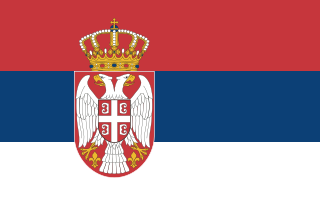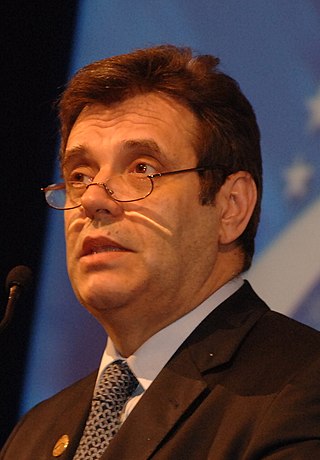Primary education
| | This section needs expansion. You can help by adding to it. (November 2008) |
- Primary school "Petar Petrovic Njegos"
This is a list of educational institutions located in Belgrade , Serbia.
Gymnasiums in Belgrade:
| | This section needs expansion. You can help by adding to it. (November 2008) |

Serbia, officially the Republic of Serbia, is a landlocked country at the crossroads of Southeast and Central Europe, located in the Balkans and the Pannonian Plain. It borders Hungary to the north, Romania to the northeast, Bulgaria to the southeast, North Macedonia to the south, Croatia and Bosnia and Herzegovina to the west, and Montenegro to the southwest. Serbia claims a border with Albania through the disputed territory of Kosovo. Serbia has about 6.6 million inhabitants, excluding Kosovo. Its capital Belgrade is also the largest city.

Ivo Andrić was a Yugoslav novelist, poet and short story writer who won the Nobel Prize in Literature in 1961. His writings dealt mainly with life in his native Bosnia under Ottoman rule.

The Serbian Orthodox Church is one of the autocephalous Eastern Orthodox Christian churches.

Vojislav Koštunica is a Serbian former politician who served as the last president of FR Yugoslavia from 2000 to 2003 and as the prime minister of Serbia from 2004 to 2008.

The First Serbian Uprising was an uprising of Serbs in Orašac against the Ottoman Empire from 14 February 1804, to 7 October 1813. The uprising began as a local revolt against the Dahije, who had seized power in a coup d'état. It later evolved into a war for independence, known as the Serbian Revolution, after more than three centuries of Ottoman Empire rule and brief Austrian occupations.

The University of Belgrade is a public research university in Belgrade, Serbia. It is the oldest and largest modern university in Serbia.

New Belgrade is a municipality of the city of Belgrade. It was a planned city and now is the central business district of Serbia and South East Europe. Construction began in 1948 in a previously uninhabited area on the left bank of the Sava river, opposite old Belgrade. In recent years [when?], it has become the central business district of Belgrade and its fastest developing area, with many businesses moving to the new part of the city, due to more modern infrastructure and larger available space. With 209,763 inhabitants, it is the second most populous municipality of Serbia after Novi Sad.

The Austro-Turkish War (1716–1718) was fought between Habsburg monarchy and the Ottoman Empire. The 1699 Treaty of Karlowitz was not an acceptable permanent agreement for the Ottoman Empire. Twelve years after Karlowitz, it began the long-term prospect of taking revenge for its defeat at the Battle of Vienna in 1683. First, the army of Turkish Grand Vizier Baltacı Mehmet defeated Peter the Great's Russian Army in the Russo-Turkish War (1710–1711). Then, during the Ottoman–Venetian War (1714–1718), Ottoman Grand Vizier Damat Ali reconquered the Morea from the Venetians. As the guarantor of the Treaty of Karlowitz, the Austrians threatened the Ottoman Empire, which caused it to declare war in April 1716.

Slobodan Jovanović was a Serbian and Yugoslav writer, historian, lawyer, philosopher, literary critic, diplomat, politician and one of the most prominent intellectuals of his time. He was the professor at the University of Belgrade Faculty of Law (1897—1940), Rector of the University of Belgrade, and the President of the Serbian Royal Academy (1928–1931). He took part at the Paris Peace Conference (1919) as an expert for the Yugoslav Government.

German bombing of Belgrade, or Operation Retribution, also known as Operation Punishment, was the April 1941 German bombing of Belgrade, the capital of Yugoslavia, in retaliation for the coup d'état that overthrew the government that had signed the Tripartite Pact. The bombing occurred in the first days of the German-led Axis invasion of Yugoslavia during World War II. The Royal Yugoslav Army Air Force (VVKJ) had only 77 modern fighter aircraft available to defend Belgrade against the hundreds of German fighters and bombers that struck in the first wave early on 6 April. Three days prior, VVKJ Major Vladimir Kren had defected to the Germans, disclosing the locations of multiple military assets and divulging the VVKJ's codes.
A faculty is a division within a university or college comprising one subject area or a group of related subject areas, possibly also delimited by level. In North America, academic divisions are sometimes titled colleges, schools, or departments, with universities occasionally using a mixture of terminology, e.g., Harvard University has a Faculty of Arts and Sciences and a Law School.

The Serbian Academy of Sciences and Arts is a national academy and the most prominent academic institution in Serbia, founded in 1841 as Society of Serbian Letters.

Milovan Danojlić was a Serbian poet, essayist and literary critic best known for his children's poetry. Danojlić was a full member of the Serbian Academy of Science and Arts.

The Faculty of Law of the University in Belgrade, also known as the Belgrade Law School, is one of the first-tier educational institutions of the University of Belgrade, Serbia. The building is located in the heart of the old part of Belgrade, in the urban neighborhood of Palilula, contiguously to the city park Tašmajdan, on Bulevar kralja Aleksandra.

The Mansion of Miša Anastasijević is one of the most notable buildings in Belgrade, Serbia. It is the University of Belgrade's administration and governance building.

The University of Arts in Belgrade is a public university in Serbia. It was founded in 1957 as the Academy of Arts to unite four academies. It became a university and acquired its current name in 1973.

The University of Belgrade Faculty of Philosophy, established in 1838 within the Belgrade Higher School, is the oldest Faculty at the University of Belgrade. It is a modern social science education institution, adapting to current educational trends worldwide.The Faculty building is located at the meeting point of the Čika-Ljubina with the Knez Mihailova Street, the main pedestrian and shopping zone in Belgrade, Stari Grad.
Sima Ćirković was a Yugoslav and Serbian historian. Ćirković was a member of the Academy of Sciences and Arts of Bosnia and Herzegovina, the Yugoslav Academy of Sciences and Arts, the Montenegrin Academy of Sciences and Arts, the Serbian Academy of Sciences and Arts and the Vojvodina Academy of Sciences and Arts. His works focused on medieval Serbian history.

Archbishopric of Belgrade and Karlovci is the central or patriarchal eparchy of the Serbian Orthodox Church, with seat in Belgrade, Serbia. The head of the eparchy is the Serbian patriarch.

The siege of Belgrade in 1690 was the fifth siege of that city, taking place during the Great Turkish War.